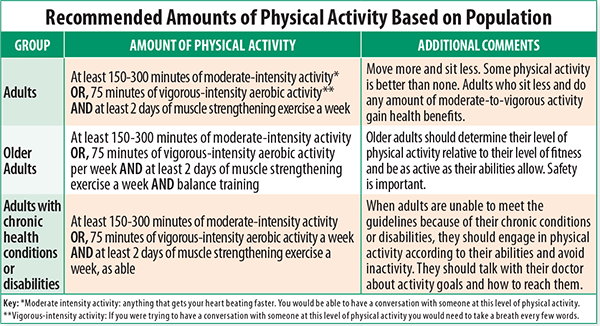Physical Activity Guidelines for Americans: Move More!
In 2008, the Office of Disease Prevention and Health Promotion developed the first set of physical activity guidelines ever for the American public. These guidelines are the authoritative voice for how physical activity can help promote health and decrease a person’s risk of disease. But most Americans had difficulty following the guidelines with only 20% of adults and adolescents meeting them. Ten years later in November of 2018, with additional expert advice and public comment considered, the second set of physical activity guidelines were published. The main message for every American—move more, sit less! Some activity is better than none.
Long Term Benefits of Physical Activity:
- Improve cognition for those with ADHD, multiple sclerosis, and Parkinson’s disease
- Reduce anxiety and depression
- Help prevent eight types of cancer (bladder, breast, colon, endometrium, esophagus, kidney, stomach, and lung)
- Reduce dementia
- Reduce heart disease
- Reduce stroke
- Reduce high blood pressure
- Reduce type 2 diabetes
- Improve bone health
- Improve physical function
- Improve quality of life
- Help maintain weight
- Improve the risk of falls
- Decrease osteoarthritis pain
Benefits of physical activity. Over the past decade, scientific evidence supporting the benefits of physical activity has expanded. Most people think exercise’s main benefit is helping you to lose and maintain weight, however, the benefits are really much more extensive and more immediate. Being more physical has instant benefits like helping to boost your mood, sharpen your focus, reduce stress, and improve your sleep. Over time, physical activity can help you live a longer, healthier life by reducing the risk of several chronic diseases like cancer, heart disease, diabetes, and dementia.
How Much Do You Need? The guidelines for how much physical activity we need can feel overwhelming, but remember, the most important guideline is move more and sit less! Adults who sit less and do any amount of moderate-to-vigorous physical activity gain some health benefits so don’t despair if you don’t meet the recommendations developed by the committee.
MOVE MORE, SIT LESS!
Some physical activity is better than none. Adults who sit less and do any amount of moderate-to-vigorous activity gain health benefits.
The overall amount of physical activity recommended for adults stays the same as the previous guidelines (at least 150–300 minutes of moderate-intensity activity or 75–150 minutes of vigorous-intensity aerobic activity a week), but the requirement that physical activity needed to be in bouts of at least ten minutes in order to be effective was withdrawn. This allows people more flexibility in meeting physical activity recommendations throughout the day. The guidelines also include counting lower intensity activities that are a part of everyday living or things that don’t feel like exercise. This includes activities like housework, grocery shopping, gardening, working on a car engine, playing catch with a ball, stretching, yoga, desk calisthenics, playing with your kids, and much more.
In addition to adults, the Physical Activity Advisory Committee also developed guidelines for special populations including children age 3 to 17, older adults, women during pregnancy and postpartum, adults with chronic diseases, and adults with disabilities. Anyone who is inactive should consult with a physician prior to engaging in a moderate-to-vigorous-intensity physical activity plan.
How to get started: If you’re someone that’s not physically active and you want to change that, the expectations for success are now easier than ever—just move more, sit less. All the activity in a day counts toward the weekly recommendation. Even with a minimal increase in physical activity you’ll experience benefits. For more tips, visit the Move Your Way website at: https://health.gov/moveyourway/
—Tamara Schryver, PhD, RD

The post Physical Activity Guidelines for Americans: Move More! appeared first on University Health News.
Read Original Article: Physical Activity Guidelines for Americans: Move More! »
Powered by WPeMatico

